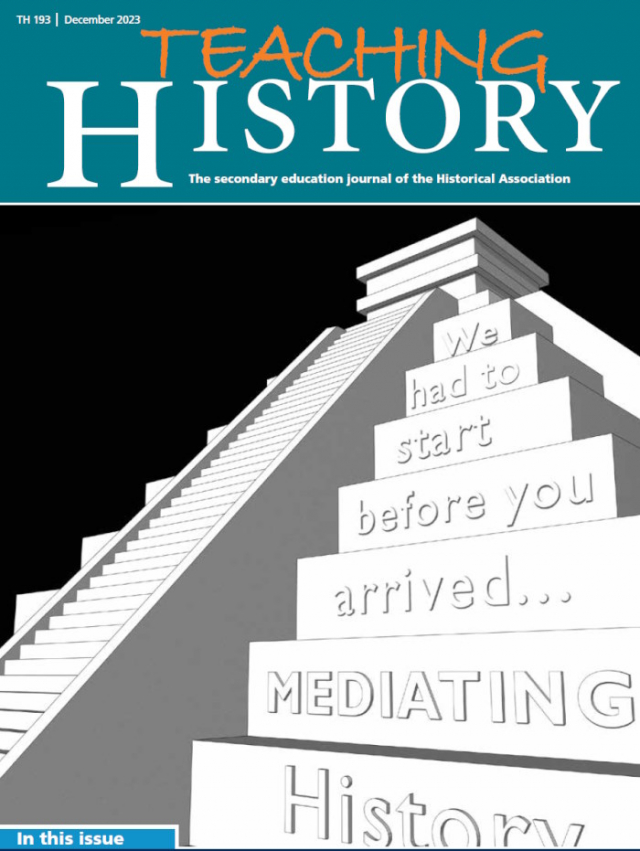Teaching History 193: Out now
The HA's journal for secondary history teachers

Editorial: Mediating history
Read Teaching History 193: Mediating History
David Lowenthal writes that history is both less than and more than the past. It is less because ‘only a tiny fraction of all that has happened can ever be recovered and recounted’.1 Yet it is also more because ‘it is a new and finer form of the original… in a new order. The facts which transpired do not lie in it inert; but some subside and others shine, so that soon we have a new picture.’2
In doing so, Lowenthal shows how all encounters with the past are mediated: ‘imparting and imbibing his tory depends on precursors’ vision and voice, recipients’ eyes and ears: interpreters and receivers manage our apprehension of past events.’3 Nor is it just professional historians who seek to mediate the past. Indeed, Samuel argues that, far from being the prerogative of the historian, history, as a social form of knowledge, is ‘the work, in any given instance of a thousand different hands’.4 Arguably among the most important of those hands are those of the history teacher.
All the history teachers writing in this edition show a strong awareness of their role in mediating both the past and history for their pupils.
Hopkins and Grady both share a concern with the role played by pupils’ own imaginations in mediating the past. In arguing that history is an imaginative reconstruction of a vanished past, they argue for the importance of attending to the knowledge that will furnish pupils’ historical imaginations. The approaches they take to developing this knowledge differ, however. Grady, inspired by Hill’s approach to ‘world building’ and Benger’s work on the reconstruction of past perspectives, combined the two approaches. She argues that, even in a time-constrained curriculum, it is possible to build the kind of rich, hinterland knowledge pupils need if they are to imaginatively reconstruct the past.
Hopkins, in seeking to make his own storytelling in the classroom a more powerful tool for building his students’ pictures of the past, turned to the immersive approaches taken by some museums. He argues that his innovative approach – ‘immersive meditative storytelling’ – in forcing pupils to engage in an act of imaginative reconstruction, both sustained their engagement with the narrative and built more enduring knowledge.
Casey, in exploring the role analogies can play in developing pupils’ historical understanding, argues that explicitly drawing connections between past and present can help pupils to perceive the relevance of the past to their own lives. While acknowledging the risks of connecting past and present, Casey nonetheless argues that directly engaging with presentism foregrounds the inevitable role played by the present in mediating the past. In his article, Casey sets out how he used a present-day analogy to sharpen pupils’ understanding of the differences between past and present, while also showing them its relevance to their own lives.
Southwood, upon the discovery of a large uncatalogued archive in her own school, immediately saw its potential to help teach her pupils how to do history. In teaching pupils how to use the sources in the archive to write their own school’s history, she showed them how the past is mediated through both the traces of it that survive and the people who use those traces to construct an account of it.
Jennings was concerned with developing her pupils’ understanding of why some narratives become entrenched as popular orthodoxies. Taking inspiration from the historian Camilla Townsend’s use of Mexica (Aztec) sources to foreground Mexica experiences and perspectives of before, during and after the arrival of Spanish conquistadors, Jennings set about using Townsend’s account of her research process to get her Year 7 pupils reflecting critically on how stereotypes of the Mexica were formed, and why those stereotypes have endured in the popular imagination for so long. In the course of her enquiry, she showed her pupils the role played by the media in mediating the past and perpetuating certain accounts.
Finally, Counsell warns about the dangers of allowing summative assessment to dictate our goals and teaching. She reminds us of the importance of the history teacher’s role in mediating the past for our pupils, and of ensuring that the mode of our assessment does not distort meaningful history.
References
1. Lowenthal, D. (2015) The Past is a Foreign Country – Revisited, Cambridge: Cambridge University Press, p. 336.
2. Emerson, R. W. (1850) cited by Lowenthal, D.
(2015) ibid., p. 340.
3. Lowenthal, D. (2015) ibid., p. 338.
4. Samuel, R. (2012) Theatres of Memory: past and present in contemporary culture, London; New York: Verso, p. 30.

